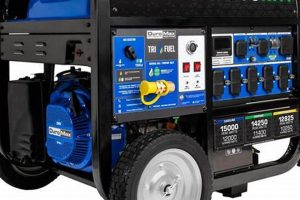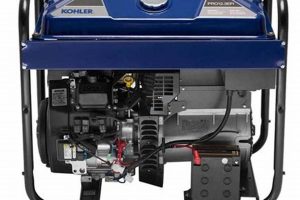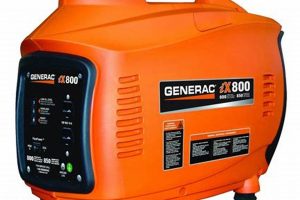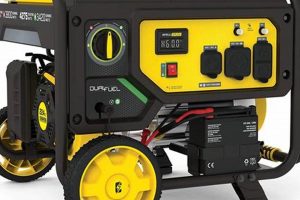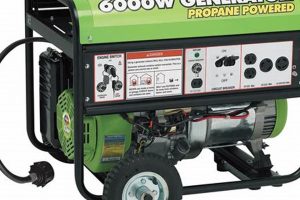Compact, fuel-powered devices designed for outdoor use provide electrical power where utility access is unavailable. These devices utilize propane, a readily available and easily stored fuel, to generate electricity sufficient to operate appliances such as lights, refrigerators, and small electronics typically used in recreational settings. This independence from the power grid makes them valuable for activities such as tent camping, RVing, and tailgating.
Offering a convenient power source away from civilization, these units empower users to maintain comfort and safety during outdoor adventures. They enable the use of essential equipment, enhancing experiences by providing light, preserving food, and enabling communication. The evolution from noisy, bulky generators to quieter, more efficient models has increased their practicality and popularity among outdoor enthusiasts.
Understanding the selection, operation, and maintenance of such power sources is critical for safe and effective use. Topics such as appropriate sizing, fuel efficiency, noise levels, and safety precautions will be explored further in this guide.
Tips for Safe and Effective Generator Use
Careful planning and operation are essential for maximizing the benefits and minimizing the risks associated with power generation in outdoor settings. Adherence to the following guidelines will ensure safe and efficient operation.
Tip 1: Calculate Power Needs: Determine the wattage requirements of all devices intended for simultaneous use. Generator capacity should exceed the combined wattage. Overloading can damage both the generator and connected equipment.
Tip 2: Prioritize Ventilation: Operate the unit in a well-ventilated area to prevent the accumulation of carbon monoxide, a colorless, odorless, and deadly gas. Never operate indoors or in enclosed spaces.
Tip 3: Maintain a Safe Distance: Position the generator away from tents, sleeping areas, and flammable materials. A minimum distance of 20 feet is recommended.
Tip 4: Ground the Generator: Proper grounding is crucial for preventing electrical shock. Consult the owner’s manual for grounding instructions specific to the model.
Tip 5: Refuel Safely: Turn off the generator and allow it to cool completely before refueling. Avoid spilling fuel and never refuel near an open flame.
Tip 6: Regular Maintenance: Adhere to the manufacturer’s recommended maintenance schedule, including oil changes, air filter cleaning, and spark plug replacement. Regular maintenance ensures optimal performance and extends the lifespan of the unit.
Tip 7: Store Properly: When not in use, store the generator in a dry, well-ventilated area away from flammable materials and out of reach of children.
By following these guidelines, users can ensure safe, efficient, and trouble-free operation, enhancing the enjoyment and safety of their outdoor experiences.
Proper use and maintenance contribute significantly to the reliability and longevity of these valuable power sources, allowing for continued enjoyment of the outdoors.
1. Portability
Portability is a defining characteristic of generators intended for outdoor recreational use. Ease of transport directly impacts usability, influencing where and how these power sources can be deployed. Various factors contribute to a generator’s portability, each playing a crucial role in overall convenience and practicality.
- Weight and Dimensions
The physical size and weight of the unit dictate ease of handling and transport. Compact, lightweight models are more easily maneuvered across uneven terrain or stowed in vehicles with limited cargo space. Conversely, larger, heavier units may require assistance or specialized transport methods, limiting their practicality in certain scenarios. For example, a backpackable generator offers significant advantages for hikers, while a larger unit on wheels might be more suitable for car camping.
- Integrated Handles and Wheels
Ergonomic design features such as integrated handles and durable wheels significantly improve portability. Well-placed handles allow for balanced lifting, while sturdy wheels facilitate transport over various surfaces. A generator equipped with both handles and wheels can be easily moved by a single person, even across rough ground, while a unit lacking these features might prove cumbersome and difficult to manage.
- Compact Storage and Assembly
Generators designed for portability often feature collapsible handles and compact frames, minimizing storage space requirements. Simplified assembly procedures, requiring minimal tools and effort, further enhance convenience. A generator that can be quickly and easily assembled and disassembled onsite streamlines setup and takedown, contributing to a more efficient and enjoyable camping experience.
- Case Material and Durability
The materials used in the generator’s construction directly impact its ability to withstand the rigors of transport and outdoor use. Robust materials such as high-impact plastics or reinforced metals protect internal components from damage during transit and contribute to overall longevity. A durable case ensures that the generator can withstand bumps and vibrations associated with transport, maintaining its functionality and reliability over extended periods.
The interplay of these factors determines the true portability of a generator. Careful consideration of weight, dimensions, design features, and construction materials is essential for selecting a unit that aligns with individual needs and intended applications, ensuring a seamless integration of power generation into the overall camping experience.
2. Fuel Source (Propane)
Propane’s characteristics as a fuel source significantly influence the design and functionality of portable generators intended for camping. Its widespread availability, ease of storage, and clean-burning properties make it a practical choice for powering devices in outdoor environments. The portability of propane, achieved through readily available pressurized canisters, eliminates the need for cumbersome fuel tanks or jerry cans, aligning seamlessly with the portability requirements of camping equipment. Furthermore, propane’s relatively clean combustion minimizes environmental impact compared to gasoline-powered alternatives, an important consideration in natural settings.
The reliance on propane dictates specific design considerations within the generator itself. Specialized components, including a propane regulator and carburetor, are necessary to manage fuel delivery and ensure efficient combustion. These components, while adding to the overall complexity of the generator, contribute to its ease of use and reliability. For instance, the propane regulator controls fuel flow, ensuring consistent performance across varying altitudes and temperatures, a crucial factor for reliable operation in diverse camping environments. The relatively low maintenance requirements of propane-powered generators, stemming from the clean-burning nature of the fuel, further enhance their practicality in remote locations.
Understanding the relationship between propane as a fuel source and the design and operation of portable generators allows for informed selection and effective utilization. Factors such as fuel efficiency, runtime based on canister size, and the availability of propane refills in different locations should influence purchasing decisions and trip planning. Safe handling and storage of propane canisters are paramount for accident prevention. Appropriate ventilation during operation is crucial due to the production of combustion byproducts, albeit cleaner than gasoline alternatives. Awareness of these factors contributes significantly to safe and successful outdoor power generation, ensuring the enjoyment and safety of camping experiences.
3. Power Output
Power output, measured in watts, represents a critical specification for portable propane generators designed for camping. This metric directly dictates the generator’s ability to operate various electrical devices, influencing its suitability for different applications. Understanding the relationship between power output and the electrical demands of camping equipment is crucial for successful power management in off-grid environments. Insufficient power output results in the inability to run essential devices or the risk of overloading the generator, leading to potential damage or safety hazards. Conversely, excessively high power output translates to increased fuel consumption and unnecessary weight, impacting portability and efficiency. For example, a generator with a power output of 1000 watts might suffice for powering a small refrigerator and a few LED lights, while operating a microwave or an electric heater would necessitate a significantly higher output.
Matching power output to specific needs requires careful consideration of intended usage scenarios. Calculating the combined wattage of all devices planned for simultaneous operation is crucial. Adding a safety margin to this calculation ensures adequate power availability and prevents overloading. Manufacturers typically provide detailed specifications regarding continuous and surge power output. Continuous power output signifies the sustained power delivery capability, while surge power output refers to the generator’s ability to handle temporary power spikes during appliance startup. Understanding these distinctions allows for informed selection and prevents unexpected power interruptions during operation. For instance, a coffee maker might require a higher surge wattage during its initial heating cycle, while its continuous power draw would be significantly lower.
Optimizing power output contributes to an efficient and reliable power supply in camping scenarios. Accurately assessing power requirements and selecting a generator with appropriate output ensures seamless operation of essential devices without compromising safety or efficiency. This understanding facilitates informed decisions regarding generator selection and power management strategies, contributing significantly to a positive and successful camping experience. Failure to match power output to demand can lead to frustration, equipment malfunction, or safety risks, highlighting the practical significance of this key generator specification.
4. Safety Features
Safety features represent critical components of portable propane generators designed for camping, mitigating potential hazards associated with fuel combustion and electricity generation in outdoor environments. These features work in concert to protect users and surrounding equipment from harm, ensuring a secure and enjoyable camping experience. A comprehensive understanding of these safety mechanisms and their functions is essential for responsible generator operation. Neglecting safety precautions can lead to serious incidents, including carbon monoxide poisoning, fire, or electrical shock, underscoring the practical significance of these integrated safeguards.
Several key safety features are commonly incorporated into modern portable propane generators. Automatic shutoff valves interrupt fuel supply in the event of low oil pressure or overheating, preventing engine damage and potential fire hazards. Carbon monoxide detectors monitor the surrounding air for dangerous levels of this odorless, colorless gas, automatically shutting down the generator if a threshold is exceeded. This feature is particularly crucial in camping scenarios where ventilation may be limited. Spark arrestors prevent the escape of sparks from the exhaust, minimizing fire risks, especially in dry environments. Overload protection circuits interrupt power output when electrical demand exceeds the generator’s capacity, protecting connected devices and the generator itself from damage. Clearly marked operating instructions and safety warnings provide users with essential information for safe and effective operation. For instance, a generator equipped with an automatic shutoff valve will cease operation if oil levels drop below a critical threshold, preventing catastrophic engine failure and potential fire. Similarly, a carbon monoxide detector will trigger an automatic shutdown if dangerous levels of the gas accumulate, safeguarding users from this potentially fatal hazard.
Careful consideration of safety features during generator selection is paramount for mitigating risks associated with outdoor power generation. Prioritizing models equipped with comprehensive safety mechanisms significantly enhances user safety and contributes to a more secure camping environment. Routine inspection and maintenance of these features, including testing and cleaning, ensure their continued effectiveness. Understanding the function and importance of each safety feature empowers users to operate portable propane generators responsibly, minimizing potential hazards and maximizing the enjoyment of outdoor experiences. Ignoring safety precautions can have severe consequences, reinforcing the practical importance of these integrated safeguards in portable power generation for camping.
5. Maintenance
Regular maintenance is essential for ensuring the reliable and safe operation of a portable propane generator used in camping scenarios. Neglecting routine upkeep can lead to decreased performance, increased fuel consumption, and potentially hazardous malfunctions. A well-maintained generator provides consistent power delivery, extending its lifespan and enhancing the overall camping experience. Conversely, a poorly maintained unit can become unreliable, resulting in power outages, equipment damage, or even safety risks. Understanding the key maintenance requirements and adhering to a regular maintenance schedule are crucial for maximizing the benefits and minimizing the risks associated with portable power generation in outdoor environments.
- Oil Changes
Regular oil changes are fundamental to maintaining engine health and performance. Engine oil lubricates moving parts, reducing friction and preventing excessive wear. Over time, oil degrades, losing its lubricating properties and accumulating contaminants. Failing to change the oil at recommended intervals can lead to increased engine wear, decreased fuel efficiency, and potentially catastrophic engine failure. Consult the generator’s owner’s manual for specific oil type and change frequency recommendations. For example, a typical recommendation might involve changing the oil every 50 hours of operation or annually, whichever comes first.
- Air Filter Cleaning/Replacement
Clean air filters are crucial for optimal engine performance. The air filter prevents dust, debris, and insects from entering the engine’s combustion chamber. A clogged air filter restricts airflow, reducing combustion efficiency and increasing fuel consumption. This can lead to decreased power output and increased engine strain. Regular cleaning or replacement of the air filter, as specified in the owner’s manual, ensures adequate airflow and maintains optimal engine performance. In dusty or dirty environments, more frequent cleaning or replacement may be necessary. For example, some generators may require air filter cleaning every 25 hours of operation, while others may recommend replacement annually.
- Spark Plug Inspection/Replacement
Spark plugs ignite the fuel-air mixture within the engine’s combustion chamber. Over time, spark plugs can become fouled or worn, leading to inefficient combustion and difficulty starting the generator. Regular inspection and replacement of spark plugs, as recommended by the manufacturer, ensures reliable ignition and optimal engine performance. Inspecting the spark plug for wear or fouling can often indicate other underlying engine issues. For example, a heavily fouled spark plug might suggest an overly rich fuel mixture or an oil leak.
- Fuel System Maintenance
Maintaining the fuel system is crucial for preventing fuel-related issues and ensuring reliable operation. This includes periodically checking for leaks, inspecting fuel lines and connections, and ensuring proper fuel storage. Propane systems require specific attention to connections and seals to prevent leaks. Storing propane canisters in a cool, dry place away from direct sunlight helps maintain fuel quality and prevents pressure buildup. Inspecting fuel lines for cracks or damage and ensuring tight connections can prevent leaks and ensure safe operation.
Adhering to a comprehensive maintenance schedule, encompassing these key areas, contributes significantly to the longevity, reliability, and safety of a portable propane generator used for camping. Regular maintenance minimizes the risk of malfunctions and ensures consistent power delivery, allowing for a more enjoyable and worry-free outdoor experience. Failing to perform routine maintenance can result in costly repairs, inconvenient power outages, and potentially hazardous situations. By prioritizing maintenance, users can maximize the lifespan of their generator and enjoy the benefits of reliable power generation in remote locations.
Frequently Asked Questions
This section addresses common inquiries regarding the selection, operation, and maintenance of portable propane generators suitable for camping applications. Clarity on these topics facilitates informed decision-making and promotes safe and effective generator use in outdoor environments.
Question 1: How is the appropriate generator size determined for camping needs?
Generator sizing depends on the combined wattage requirements of all devices intended for simultaneous use. Calculating total wattage and adding a safety margin ensures adequate power availability without overloading the generator.
Question 2: What safety precautions are essential when operating a propane generator in a campsite?
Operating the generator in a well-ventilated area away from flammable materials and sleeping quarters is crucial. Proper grounding and adherence to refueling procedures are essential for preventing accidents. Carbon monoxide alarms are recommended.
Question 3: How does altitude affect generator performance, and what adjustments are necessary?
Higher altitudes can reduce engine power output due to thinner air. Some generators require carburetor adjustments to compensate for altitude changes. Consulting the owner’s manual for specific instructions is recommended.
Question 4: What maintenance tasks are essential for ensuring optimal generator performance and longevity?
Regular maintenance includes oil changes, air filter cleaning or replacement, and spark plug inspection/replacement. Adhering to the manufacturer’s recommended maintenance schedule maximizes generator lifespan and reliability.
Question 5: What are the environmental considerations associated with using a propane generator while camping?
While propane burns cleaner than gasoline, emissions are still produced. Minimizing generator runtime and adhering to proper operating procedures reduces environmental impact. Disposing of used oil and other consumables responsibly is essential.
Question 6: What are the typical runtimes one can expect from different sizes of propane canisters?
Runtime depends on generator power output and canister size. Manufacturers typically provide estimated runtimes based on various canister sizes. Optimizing power consumption can extend runtime.
Understanding these frequently asked questions equips individuals with the knowledge necessary for safe and effective generator operation while camping. Thorough research and adherence to safety guidelines contribute to a positive and trouble-free outdoor experience.
Further exploration of specific generator models and features can provide additional insights for informed purchasing decisions.
Portable Propane Generators for Camping
Portable propane generators offer a practical solution for powering essential devices during camping trips. Careful consideration of factors such as power output, portability, fuel efficiency, safety features, and maintenance requirements ensures optimal performance and safe operation. Understanding the interplay of these elements allows for informed selection and effective utilization of these power sources in outdoor environments. Proper sizing ensures adequate power for intended applications, while adherence to safety guidelines mitigates potential hazards associated with fuel combustion and electricity generation in remote locations. Regular maintenance contributes to generator longevity and reliability, maximizing the benefits of portable power during camping adventures.
Responsible use and maintenance are crucial for maximizing the benefits and minimizing the environmental impact of portable propane generators in outdoor recreational settings. Continued advancements in generator technology promise further improvements in efficiency, portability, and noise reduction. Informed decision-making, guided by a comprehensive understanding of these power sources, empowers individuals to enjoy the convenience and safety of portable power while minimizing their impact on the natural environment. Thorough preparation and adherence to safety guidelines are paramount for a positive and sustainable approach to power generation during camping experiences.

